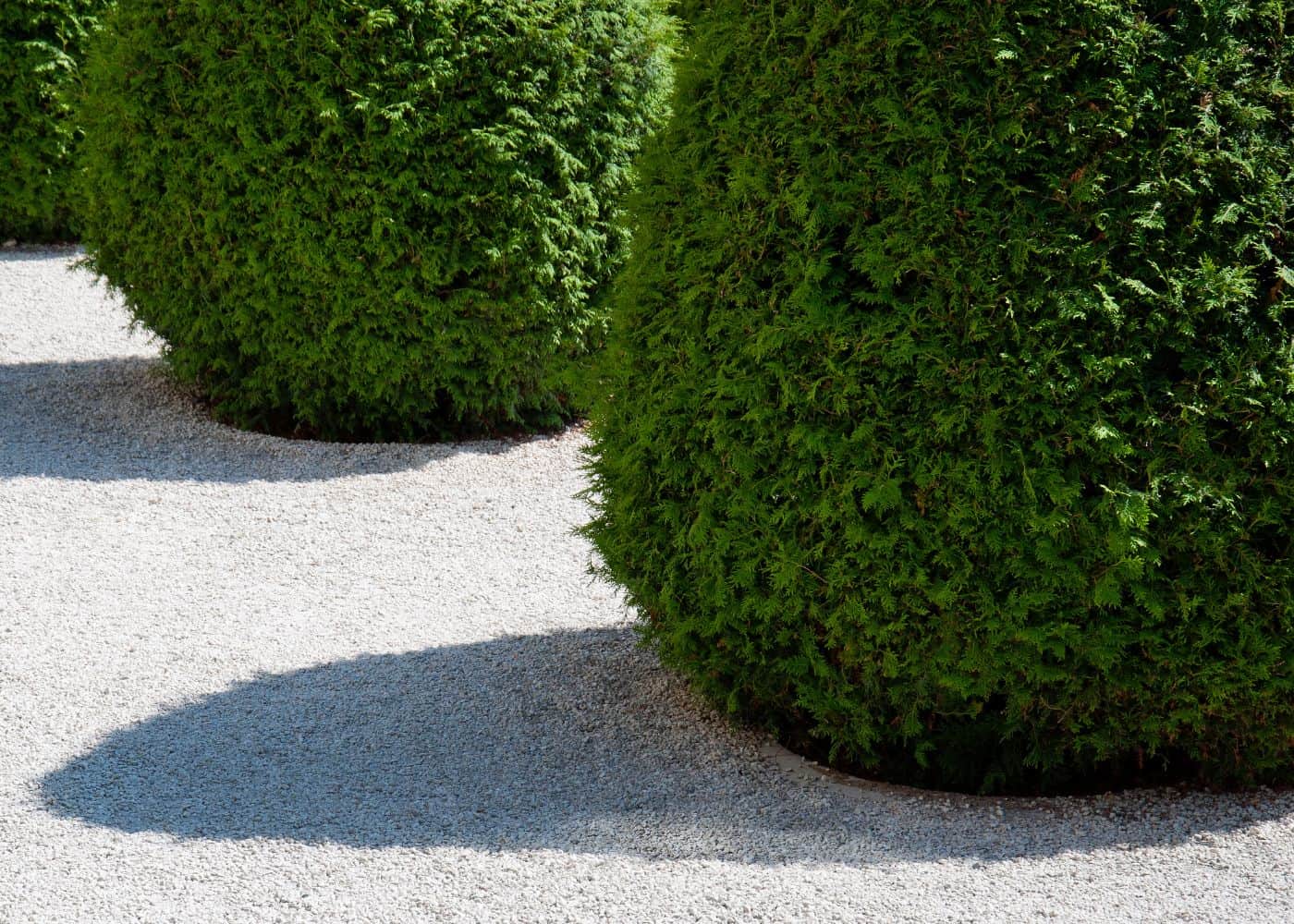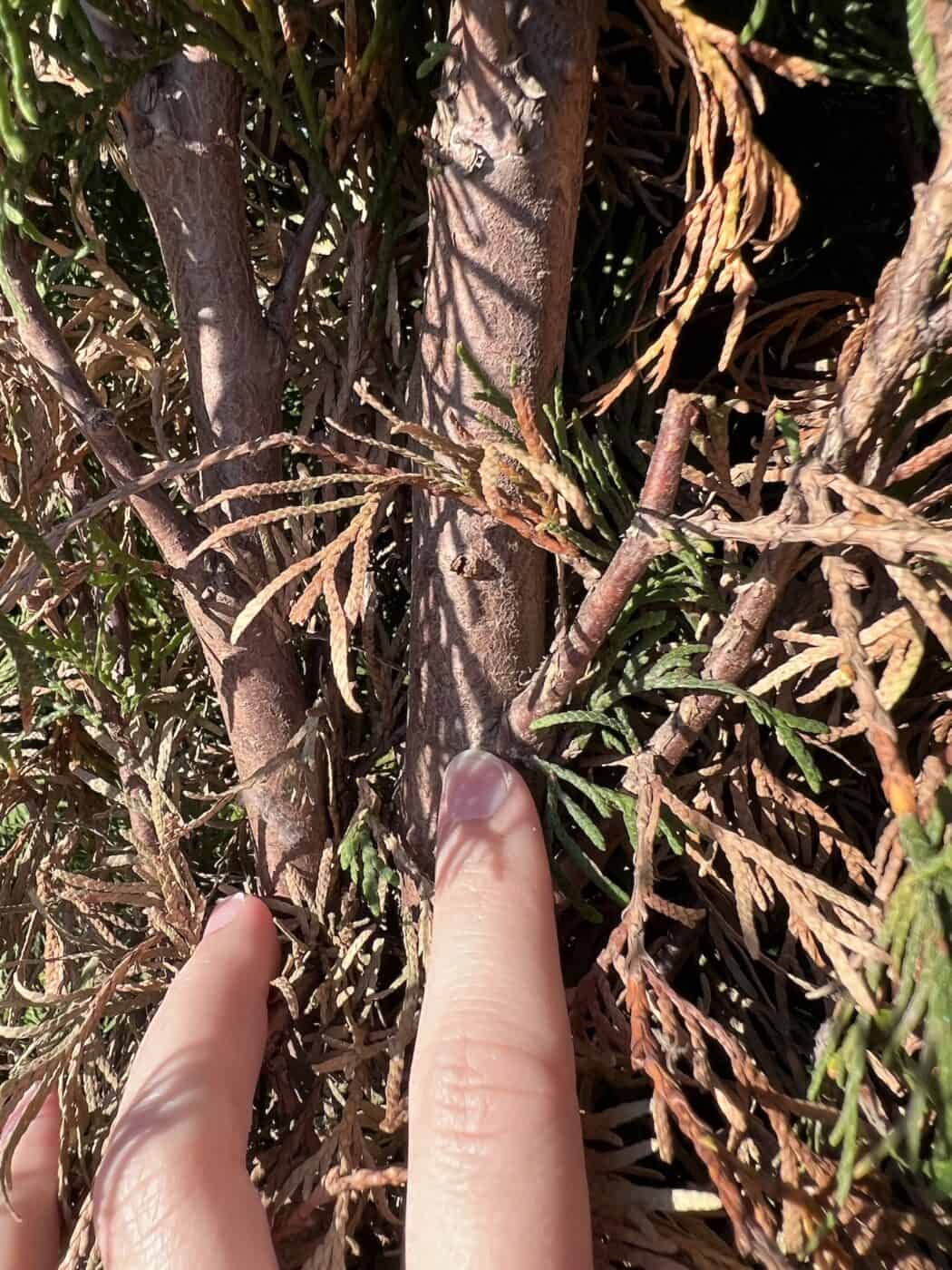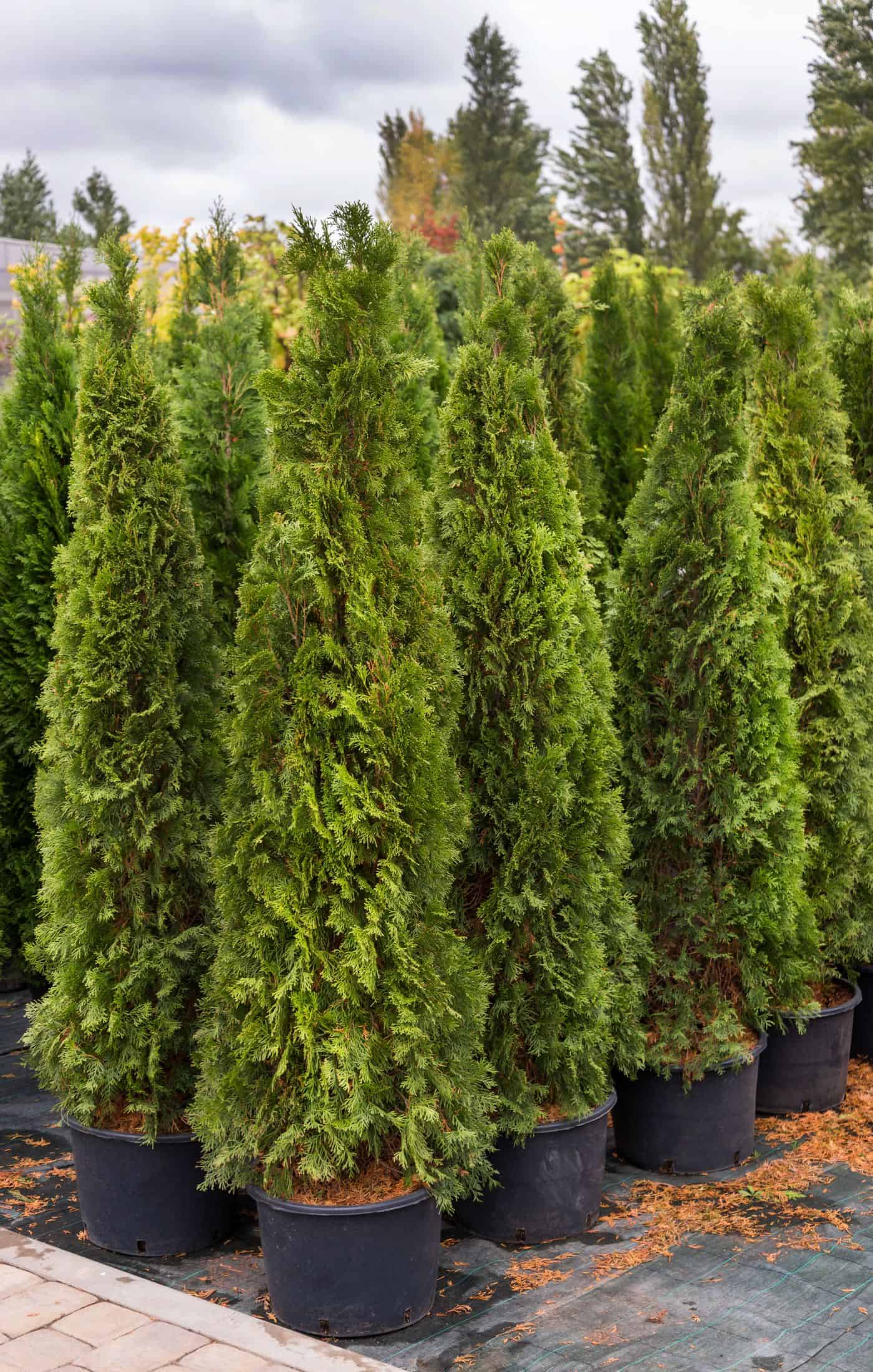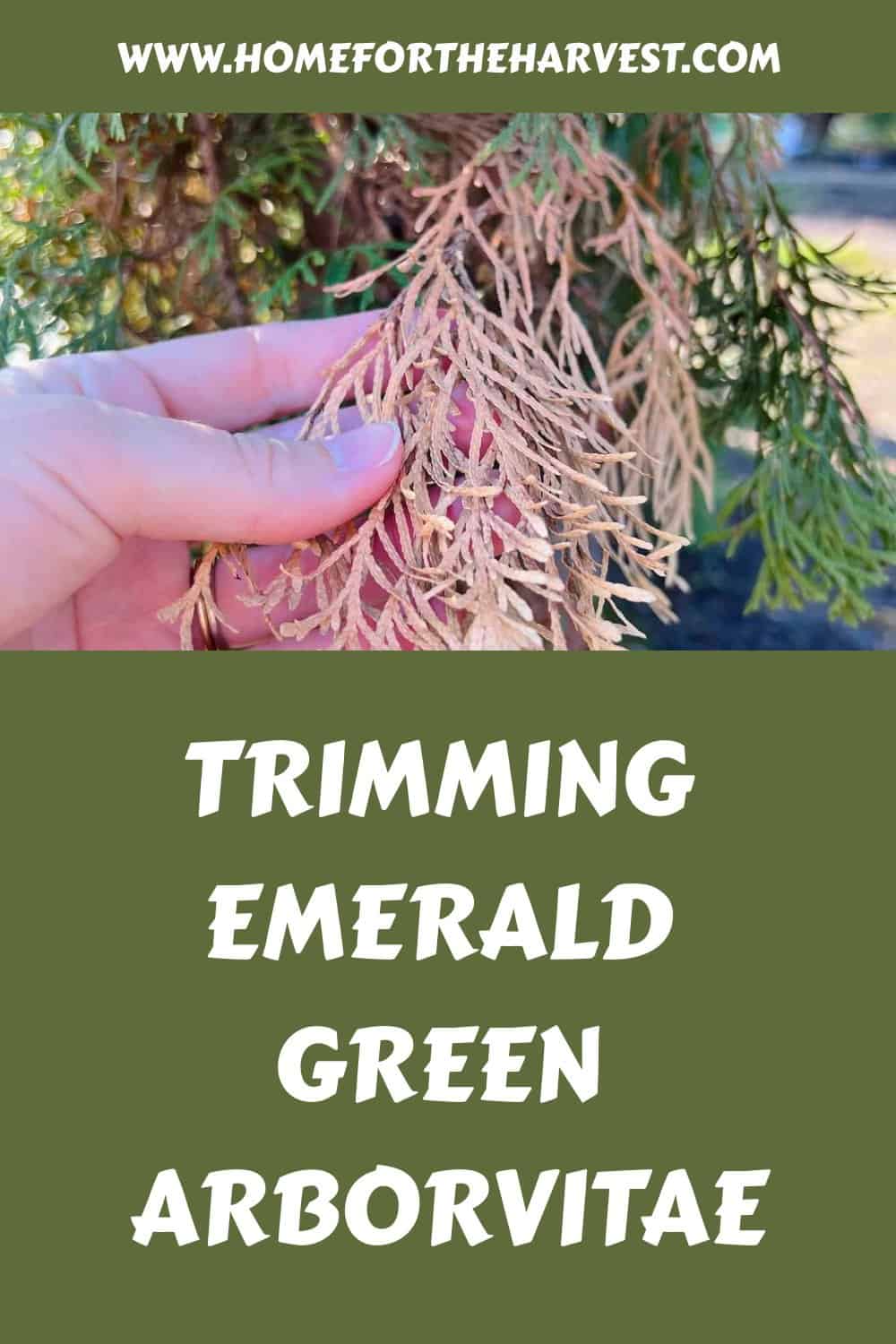Time to trim your Emerald Green arborvitae? Fortunately, it’s a relatively simple process.
Trimming Emerald Green arborvitae starts by removing any branches that are dead, dying, diseased, or severely damaged. The plant can then be trimmed for shape, including trimming a linear planting into a hedge or even shaping a single plant as a spiral topiary. Avoid pruning these plants during wet weather to minimize the chances of fungal disease.
Read on to learn all about how, when, and why to trim Arborvitae plants.

Emerald Green arborvitae pruning basics
Emerald green arborvitae generally require minimal pruning. That said, they do best when damaged branches are removed. You may also wish to shear a linear planting into a geometric hedge shape.
‘Emerald Green’ is a very popular variety of American Arborvitae. The cultivar name for this variety is ‘Smaragd,’ which roughly translates from a Nordic word for Emerald. This narrow tree is one of the top picks for fast-growing evergreen hedging plants.
Arborvitae are relatively easy to prune as they tend to regrow wherever there is foliage. They are randomly branching (not whorled branching), making pruning somewhat forgiving. This feature makes them well-suited to topiary (along with other evergreens like boxwood and yew).
“Thuja spp. (Arborvitae): This randomly branching conifer can regrow wherever there is foliage, so cut wood back either to side branches or to where foliage persists. To make the plant denser, cut back the tips of the stems, or shear.”
The Pruning Book, by Lee Reich

Reasons to trim arborvitae plants
Trimming arborvitae trees is not strictly necessary. They tend to grow in a neat, pyramidal form when left on their own (making them very low maintenance). Arborvitae pruning can, however, be helpful for the health of the plant over time. Be on the lookout for diseased branches or dead branches and remove them as soon as you can.
Pruning arborvitae can also be helpful if you want to encourage a certain shape or size. For example, if you want to create a hedge out of your emerald green arborvitae, trimming will help to control the size and shape. Trimming can also help the plant become bushier and denser.
Emerald Green arborvitae naturally grow to about 15 feet tall. If you’re looking for a shorter plant, perhaps consider a different variety that doesn’t grow as tall. This will minimize pruning maintenance. A nice dwarf alternative to Emerald Green is the Aurea Nana Arborvitae.

How to prune ‘Emerald Green’ plants?
Pruning arborvitae is very similar to pruning other conifers and evergreen shrubs. In general, do any significant pruning while the plant is dormant. Try not to remove more than 1/3 of the tree’s foliage at one time. And always remove any branches that are dead or are diseased.
Here are the basic steps for pruning Emerald Green arborvitae:
- Cut off all dead, dying, and/or severely damaged branches. Remove the branch altogether. Don’t leave a half-alive stump. For main branches, this means making a pruning cut about 3/4″ away from the trunk. Cut the whole branch off at a 90-degree angle pruning cuts so that the open wound of green wood has as small a surface area as possible.
- Cut off all diseased foliage and branches. One common condition is Arborvitae Needle Blight. The ends of the foliage tips turn brown and slowly die. This occurs when the plant becomes infected with certain fungi (Phyllosticta thujae, Pestalotiopsis), and can be caused by excessive pruning during wet weather. If you suspect Arborvitae Needle Blight, remove and discard all infected plant parts (including dead needles in the area, which may harbor the fungi). You can also treat the remaining foliage with a preventative organic copper fungicide.
- Determine whether or not to remove the lowest branches. Step back and have a look at the tree in context with the landscape. If the Arborvitae is standing alone, it may look more like a tree (and less like a shrub) if the lowest branches are removed. Removing the lowest branches of a hedge can also increase air circulation, which can help counteract disease.
- Prune the rest of the tree for shape. Shorten any overly long branches so they terminate within the foliage. This is easiest with handheld pruners. Step back regularly to consider the pruned shape and its surroundings.
- Do not cut the top off the Arborvitae unless you are quite sure this is what you want. Emerald Green Arborvitae grow naturally into a pointed narrow shape, usually reaching about 15 feet tall at maturity. If, however, they are being grown as a shorter hedge, they will have to be “topped” after they reach the desired final height of the hedge. This will encourage them to bush out rather than grow upwards. These “topped” Arborvitae will require regular pruning to keep their geometric hedge shape.
All in all, start by removing whole branches if they are dead, damaged, or diseased, and then move onto pruning the overall plant into its desired shape. As with any trimming, it’s best to start slow and see how the plant responds before doing too much. You can always trim more later if necessary!

When to trim Emerald Green arborvitae
The time to trim emerald green arborvitae is in late winter or early spring before new growth begins. This will give the plant time to recover from any pruning before the growing season starts.
Minimize pruning of young plants and instead allow them to grow and develop as naturally as possible. Do not do significant pruning during the growing season, as this can damage the plant and stunt its growth.
You can, however, give these shrubs a light shearing a few times throughout the growing season if they are mature and are growing as a formal hedge. This can be done with pruning shears or a hedge trimmer in early spring, late spring, early summer, mid-summer, late summer, and/or even early fall.
How to prune arborvitae to shape
A single Arborvitae or group of spaced trees can make a lovely evergreen planting. To allow each Emerald Green plant to fully develop around all sides, give them a wide spacing of 5-6 feet.
You can remove the lower branches to give the tree’s foliage more of a pyramidal tree-like shape. This also makes it easier to add mulch over the soil surface and adds air circulation (which can help minimize disease.
You can also trim the ends of each branch to help the plant become bushier. Removing the terminal tips encourages the Arborvitae tree to bush out, which can be quite attractive for a landscape specimen tree.
Avoid cutting the highest branch: the central leader, unless you are making a formal hedge with a flat top and the plants have already reached the desired height. Otherwise, let the leader stand proudly among the others. If you do cut off the central leader, a new leader will likely regrow to take its place (although it may look a tad lopsided).

Creating an arborvitae hedge
Arborvitae, and in particular the ‘Emerald Green’ variety, is a very popular hedge plant. These plants can be left to grow into their natural mature form as an informal hedgerow, or they can be neatly trimmed into a manicured formal hedge.
Informal Arborvitate hedgerows tend to have the trees spaced about 3 feet apart (measured from trunk center to trunk center), while formal sheared hedges may be more closely spaced. Informal hedgerows are quite low maintenance, while flat hedge surfaces require regular shearing.
If you want to shear your Arborvitae into a more formal hedge shape, wait until the plants are at least 3-4 years old. This will give it time to develop some good dense growth that can be trimmed into a nice clean hedge shape.
How often you trim will depend on how fast your plants are growing and whether or not you’re looking for a formal, manicured appearance. A general rule of thumb for formal hedges is to trim every 4-6 weeks during the growing season. You may be shearing the hedge 5-6 times each year!
Tools for pruning arborvitae
Arborvitae can be pruned with manual tools such as pruning shears and loppers or can be trimmed with a power tool such as a gas or electric hedge trimmer.
For small jobs, manual pruning tools will do just fine. For larger jobs or for those who want a perfectly manicured look, power hedge trimmers are the way to go. Just be sure to use sharp blades and take care not to damage the plant.
Safety gear such as gloves, eye protection, and long sleeves are also a good idea when trimming any plant, especially when using power tools.
As always, sanitation is important when pruning any plant. Be sure to clean your pruning tools before and after use to avoid spreading disease. You can either dip them in a bleach solution, use sanitizing wipes, or wipe them down with rubbing alcohol.
And that’s everything you need to know about trimming emerald green arborvitae! These fast-growing evergreen shrubs are a great choice for low-maintenance landscaping. With just a little bit of pruning, you can keep them looking their best.






